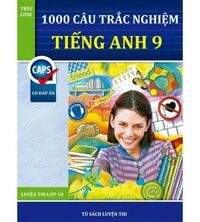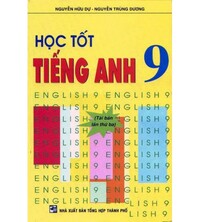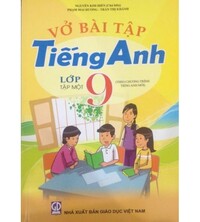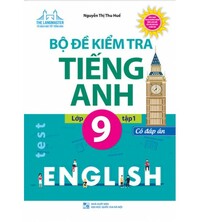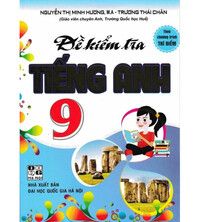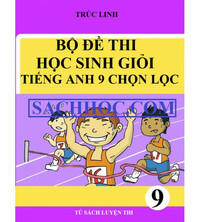Đề thi kì 1 môn tiếng Anh lớp 9 năm 2019 - 2020 Sở GD-ĐT Bến Tre
Giải chi tiết đề thi kì 1 môn tiếng Anh lớp 9 năm 2019 - 2020 Sở GD-ĐT Bến Tre với cách giải nhanh và chú ý quan trọng
|
SỞ GD – ĐT BẾN TRE
Mã đề thi 01 |
ĐỀ THI HỌC KÌ I NĂM HỌC 2019-2020 Môn thi: TIẾNG ANH – KHỐI 9 Thời gian làm bài: 45 phút
|
SECTION 1: LISTENING (2 points)
Part 1: Listen to the recording, put a tick to decide the following statements whether they are True or False and mark your answer on the answer sheet. (1 pt)
Question 1. (NB) Harry asks Jinko to pick him up at the airport next Sunday.
Question 2. (NB) Harry is living in England.
Question 3. (TH) Mary will take Jinko to Harry’s house.
Question 4. (VD) Harry shows Jinko how to get to his house.
Question 5. (TH) The man who guards the park is not friendly.
Part 2: Listen to the recording, circle the correct answer (A, B or C) for each of the following questions and mark your answer on the answer sheet. (1pt)
Question 6. (NB) What is the customer looking for in the shop?
A. casual clothes B. suits C. swimsuits
Question 7. (TH) What material are the baggy trousers made of?
A. silk B. cotton C. faded jean
Question 8. (TH) What has the customer just bought?
A. Some plain shirts
B. Some plain dresses
C. Some plaid shirts
Question 9. (NB) What do baggy trousers go with?
A. white shirts
B. long-sleeved shirts
C. T-shirts
Question 10. (NB) What is the cashier wearing?
A. a short-sleeved shirt and blue trousers
B. an embroidered skirt
C. a long dress
SECTION Il: USE OF LANGUAGE (2 points)
Choose the best option (A, B, C or D) to answer the following questions and mark your answer on the answer sheet.
Question 11. (NB)Which ASEAN country is divided into two regions by the sea?
A. Vietnam B. Malaysia
C. Indonesia D. Philippines
Question 12. (TH) Since I _______, I've made a lot of friends in the new school.
A. come B. coming
C. came D. had come
Question 13. (TH) There is a meeting _____ 9: 00 A.M and 2: 00 P.M.
A. till B. at
C. from D. between
Question 14. He is a strict _______. (NB)
A. examiner B. exam
C. examine D. examination
Question 15. “Thanks for all your help” – “_______.” (TH)
A. I’d love to B. My pleasure
C. Certainly D. My happiness
Question 16. Islamic people worship in a _____. (TH)
A. mosque B. pagoda
C. temple D. church
Question 17. “Oh no. I left my book at home. Can I share yours?” – “_______”. (NB)
A. Not at all B. Yes, I do too
C. Yes, sure D. No, thanks
Question 18. We are very busy ___ the examination is coming. (NB)
A. so B. but
C. although D. because
Question 19. " ____ live in a dormitory on campus?” “That sounds a good idea”. (VD)
A. What about B. Let's
C. Why not D. We should
Question 20. (TH) Choose the underlined word or phrase that needs correcting.
Nam uses to go fishing when he was young.
Question 21. (VD) Look at the big old tree at the _____ of the village. It's a banyan tree.
A. exit B. way
C. entrance D. going
Question 22. (TH) I speak ____ English but I want to learn to read and write it well.
A. a little B. a few
C. many D. much
Question 23. (TH) I weigh 60 kilos.
A. If I want to lose weight, I might to do some exercise.
B. If I want to lose weight, I must do some exercise.
C. If I want to lose weight, I ought to do some exercise.
D. If I want to lose weight, I ought to do some exercise.
Question 24. (VD) What is the traditional clothing of India women?
A. ao dai B. Kimono
C. Jeans D. Sari
Question 25. (VD) Choose the word that has the stress differently from that of the other words.
A. monority B. intermediate
C. occasion D. material
Question 26. (TH) Choose the word that has the underlined part pronounced differently from the others.
A. prayed B. impressed
C. designed D. embroidered
Question 27. Workers like wearing jeans because they don't_______ easily.
A. make off B. wear off
C. wear out D. make off (VD)
Question 28. The vietnamese _____ of currency is the dong.
A. lesson B. unit
C. lecture D. chapter (VD)
Question 29. (TH) I arrived in Singapore __ the evening of Thursday.
A. in B. at
C. of D. on
Question 30. Modern patterns _____ to the “ ao dai" to make it more fashionable.
A. have been added B. has been added
C. are added D. added (VD)
SECTION I: READING COMPREHENSION (2 points)
Part 1: Complete the passage with the words given and write your answer on the answer sheet: (0,4pt)
includes, larger, largest,
importance, population, majority
Is Australia the world’s (31) _______ island and its smallest continent? Actually, It's both. In fact, Australia is the only country that is also a continent. Australia has a (32)___ of about 16,5 million.That makes this island nation one of the least densely populated countries. What ethnic groups make up the Australian population? The (33) ___ of Australians are of English, Irish, Greek, Dutch and Polish. However, over the past 50 years, some four million people from more than countries have made Australia their home. This (4) ___ a large number of Asian and African immigrants.
Part 2: Read the following passage, then and mark your answer on the answer sheet answer the questlons (1,6 pts)
Last summer, Peter and his classmates went to the country. They went to visit a farm on which Peter's Uncle Tom worked, They left early in the morning and went there by bus. Uncle Tom and some workers met them at the bus stop and took them to their farm. On the way, Uncle Tom showed them the field of wheat and vegetables where some tractors were running up and down, plowing and breaking the soil, distributing manure and planting potatoes.
After lunch, they all went for a walk, In the large yard of the farm they saw some farm machines. Among them is the biggest machine which is called a combined harvester. They were told that this machine can cut and thresh corn at the same time.
In the afternoon they went to the cattle farm. Horses, sheep and cows were raised here, and cows were milked once a day. Uncle Tom also spoke about different things and about life in town and in the country, After having some tea and cakes they said goodbye and went home.
Question 35. (TH) How did Peter and his classmates go to Uncle Tom's farm?
Question 36. . (NB) What could the tractors do?
Question 37. (TH)Can the combined harvester cut and thresh corn at the same time ?
Question 38. (TH) What kinds of farm animals were raised there?
SECTION IV: WRITING (2 points)
Write the second sentences so that it has a similar meaning to the first and write your answer on the answer sheet.
Question 39. (TH) People should use bicycles for short journey.
=> Bicycles
Question 40. (TH) It's a pity, I can’t play the guitar well.
=> I wish
Question 41. (TH) Because I want to see Mr Tam, I phoned his company.
=> I want to
Question 42. (TH) "How long will you stay in Vietnam?” Nam asked Mary
=> Nam asked
Question 43. VD) It will be good to see them again.
=> I'm looking
------------------THE END------------------
HƯỚNG DẪN GIẢI
Thực hiện: Ban Chuyên môn
|
1.F |
16A |
|
2T |
17C |
|
3F |
18D |
|
4T |
19C |
|
5F |
20A |
|
6A |
21C |
|
7B |
22A |
|
8C |
23D |
|
9C |
24D |
|
10B |
25B |
|
11B |
26B |
|
12C |
27C |
|
13D |
28B |
|
14A |
29A |
|
15B |
30A |
31. largest
32. population
33. majority
34. includes
35. by bus
36. running up and down, plowing and breaking the soil, distributing manure and planting potatoes.
37. Yes, it can
38 Horses, sheep and cows
39 Bicycles should be used for short journey.
40 I wish I could play the guitar well.
41 I want to see Mr Tam, so I phoned his company.
42 Nam asked Mary how long she would stay in Viet Nam.
43 I'm looking forward to seeing them again.
GIẢI CHI TIẾT ĐỀ THI
Question 11. B
Kiến thức: Từ vựng
Giải thích:
Quốc gia Đông Nam Á nào được chia thành 2 phần bởi biển?
=> Malaysia
Chọn B
Question 12. C
Kiến thức: Thì hiện tại hoàn thành
Giải thích:
Nếu sau since thì đi với 1 mệnh đề chia ở thì quá khứ đơn
Cấu trúc: S + V (hiện tại hoàn thành) + since + S + V (quá khứ đơn)
=> Since I came, I've made a lot of friends in the new school.
Tạm dịch: Từ khi tôi đến đây tôi đã có rất nhiều người bạn ở trường mới
Chọn C
Question 13. D
Kiến thức: Giới từ
Giải thích:
from + time + to + time
between + time + and + time
=> There is a meeting between 9: 00 A.M and 2: 00 P.M.
Tạm dịch: Có một cuộc họp từ 9h sáng đến 2h chiều.
Chọn D
Question 14. A
Kiến thức: Từ loại
Giải thích:
cần điền vào chỗ trống 1 danh từ chỉ người
examiner (n): giám thị, người chấm thi
=> He is a strict examiner.
Tạm dịch: Anh ta một người chấm thi nghiêm khắc.
Chọn A
Question 15. B
Kiến thức: Giao tiếp
Giải thích:
Để đáp lại lời cảm ơn vì đã giúp đỡ của ai đó thì sử dụng câu “My pleasure” : niềm vinh hạnh của tôi.
Chọn B
Question 16. A
Kiến thức: Từ vựng
Giải thích:
mosque (n): nhà thờ Hồi giáo
pagoda (n): chùa, đền
temple (n): chùa chiền
church (n): nhà thờ
Islamic people: người Hồi giáo
=> Islamic people worship in a mosque.
Tạm dịch: Người Hồi giáo thờ phụng trong nhà thờ Hồi Giáo
Chọn A
Question 17. C
Kiến thức: Giao tiếp
Giải thích:
Đáp lại lời thỉnh cầu có thể sử dụng câu đồng ý hoặc từ chối (một cách lịch sự)
=> “Oh no. I left my book at home. Can I share yours?” – “Yes, sure”.
Tạm dịch: “Tớ để quên sách ở nhà rồi. Tớ xem chung với bạn được không?”
“Được. Chắc chắn rồi.”
Chọn C
Question 18. D
Kiến thức: Từ nối
Giải thích:
so: do vậy
but: nhưng
although: mặc dù
because: bởi vì
=> We are very busy because the examination is coming.
Tạm dịch: Chúng ta bận rộn quá vì kì thi sắp đến rồi.
Chọn D
Question 19.
Kiến thức:
Giải thích:
Một câu hỏi (vì có dấu ?) mang tính chất gợi ý làm gì
What about + V-ing ?
Why not + V?
=> " Why not live in a dormitory on campus?” “That sounds a good idea”.
Tạm dịch: Sao không ở trong kí túc xá của trường nhỉ? – Nghe hay đấy.
Chọn C
Question 20. A
Kiến thức: Cấu trúc used to
Giải thích:
Cấu trúc used to V: thường làm gì trong quá khứ và bây giờ không làm nữa.
=> Nam used to go fishing when he was young.
Tạm dịch: Nam thường hay đi câu cá khi anh ấy còn trẻ.
Chọn A
Question 21. C
Kiến thức: Tư vựng
Giải thích:
entrance (n): lối vào, cổng vào
=> Look at the big old tree at the entrance of the village. It's a banyan tree.
Tạm dịch: Có một cái cây to ở cổng làng. Đó là cây đa.
Chọn C
Question 22. A
Kiến thức: Lượng từ
Giải thích:
English là danh từ trừu tượng va không đếm được nên sử dụng a little hoặc much
xét theo ngữ cảnh trong bài (có but) nên chọn a little.
=> I speak a little English but I want to learn to read and write it well.
Tạm dịch: Tôi biết nói một chút Tiếng Anh nhưng tôi muốn học đọc và viết thật tốt.
Chọn A
Question 23. D
Kiến thức: Câu điều kiện loại 1
Giải thích:
Mang tính khuyên nhủ nên sử dụng ought to V = should + V: nên làm gì
Tạm dịch: nếu muốn giảm cân, tôi nên tập thể dục.
Chọn D
Question 24.
Kiến thức:
Giải thích:
Áo dài: trang phục truyền thống của Việt Nam
Kimono: Trang phục truyền thống của Nhật Bản
Jeans: quần bò
Sari: Trang phục truyền thống của Ấn Độ.
Tạm dịch: Trang phục truyền thống của phụ nữ Ấn Độ là gì? => Sari
Chọn D
Question 25.
Kiến thức: Trọng âm
Giải thích:
minority /maɪˈnɒr.ə.ti/
intermediate /ˌɪn.təˈmiː.di.ət/
occasion /əˈkeɪ.ʒən/
material /məˈtɪə.ri.əl/
Đáp án B có trọng âm rơi vào âm tiết 3 còn lại âm tiết 2
Chọn B
Question 26. B
Kiến thức: Phát âm đuôi “-ed”
Giải thích:
Đuôi /ed/ được phát âm là /t/: Khi động từ có phát âm kết thúc là /s/, /f/, /p/, /ʃ/, /tʃ/, /k/
Đuôi /ed/ được phát âm là /id/: Khi động từ có phát âm kết thúc là /t/ hay /d/.
Đuôi /ed/ được phát âm là /d/ với những trường hợp còn lại.
Đáp án B phát âm là /t/ còn lại là /d/
Chọn B
Question 27. C
Kiến thức: Cụm động từ
Giải thích:
make off : trốn thoát, tẩu tán
wear off: hết tác dụng (cảm xúc, sức ảnh hưởng)
wear out: mòn
=> Workers like wearing jeans because they don't wear out easily.
Tạm dịch: Những người công nhân thích mặc quần bò vì chúng không dễ mòn.
Chọn C
Question 28. B
Kiến thức: Từ vựng
Giải thích:
Sử dụng unit cho đơn vị tiền tệ
=> The vietnamese unit of currency is the dong.
Tạm dịch: Đơn vị tiền tệ của Việt Nam là đồng.
Chọn B
Question 29. A
Kiến thức: Giới từ
Giải thích:
vào các buổi trong ngày thì sử dụng: in
=> I arrived in Singapore in the evening of Thursday.
Tạm dịch: Tôi đến Singapore vào tối thứ 5.
Chọn A
Question 30. A
Kiến thức: Thì hiện tại hoàn thành
Giải thích:
Sử dụng Thì hiện tại hoàn thành để diễn tả hành động, sự việc xảy ra bắt đầu trong quá khứ, tiếp diễn đến hiện tại và chưa có dấu hiệu kết thúc.
Trong câu có sử dụng bị động với động từ add
Chủ ngữ modern patterns ở dạng số nhiều nên sử dụng have
=> Modern patterns have been added to the “ ao dai" to make it more fashionable.
Tạm dịch: Những họa tiết hiện đại được thêm vào Áo dài để trông nó thời trang hơn.
Chọn A
Question 31.
Kiến thức:
Giải thích:
Sử dụng so sánh nhất vì không có 1 vật khác để tham chiếu so sánh nên không dùng so sánh hơn được.
=> Is Australia the world’s largest island and its smallest continent?
Tạm dịch: Úc có phải là hòn đảo lớn nhất thế giới và là lục địa nhỏ nhất không?
Chọn: largest
Question 32.
Kiến thức:
Giải thích:
sau mạo từ a và trước of cần điền 1 danh từ
population (n): dân số
Australia has a population of about 16,5 million.
Tạm dịch: Úc có dân số khoảng 16,5 triệu người.
Chọn population
Question 33.
Kiến thức:
Giải thích:
sau mạo từ the và trước of cần điền 1 danh từ
majority (n): đại đa số
The majority of Australians are of English, Irish, Greek, Dutch and Polish.
Tạm dịch: Phần lớn người Úc là người Anh, Ailen, Hy Lạp, Hà Lan và Ba Lan.
Chọn majority
Question 34.
Kiến thức:
Giải thích:
Trong câu còn thiếu thành phần động từ mà chủ ngữ lại là This => động từ chia số ít.
=> This includes a large number of Asian and African immigrants.
Tạm dịch: Điều này bao gồm một số lượng lớn người nhập cư châu Á và châu Phi.
Chọn includes
Tạm dịch bài:
Úc có phải là hòn đảo lớn nhất thế giới và là lục địa nhỏ nhất không? Thật ra, đó là cả hai. Trên thực tế, Úc là quốc gia duy nhất cũng là một lục địa. Úc có dân số khoảng 16,5 triệu người. Điều đó làm cho quốc đảo này trở thành một trong những quốc gia có mật độ dân số thấp nhất. Những dân tộc nào tạo nên dân số Úc? Phần lớn người Úc là người Anh, Ailen, Hy Lạp, Hà Lan và Ba Lan. Tuy nhiên, trong 50 năm qua, khoảng bốn triệu người từ nhiều quốc gia đã biến Úc thành nhà của họ. Điều này bao gồm một số lượng lớn người nhập cư châu Á và châu Phi.
Question 35.
Kiến thức: Đọc hiểu
Giải thích:
Câu hỏi: Tom và bạn bè đến trang trại của Bác Tôm bằng phương tiện gì?
Thông tin: (câu 3 – đoạn 1) “They left early in the morning and went there by bus.”
Tạm dịch: họ rời đi từ sáng sớm và đến đó bằng xe buýt.
Đáp án: by bus
Question 36.
Kiến thức: Đọc hiểu
Giải thích:
Câu hỏi: Xe kéo có thể làm gì?
Thông tin “On the way, Uncle Tom showed them the field of wheat and vegetables where some tractors were running up and down, plowing and breaking the soil, distributing manure and planting potatoes.”
Tạm dịch: Trên đường đi, chú Tom chỉ cho họ cánh đồng lúa mì và rau quả nơi một số máy kéo đang chạy lên chạy xuống, cày xới đất, phân phát phân và trồng khoai tây.
Đáp án: running up and down, plowing and breaking the soil, distributing manure and planting potatoes.
Question 37.
Kiến thức: Đọc hiểu
Giải thích:
Câu hỏi: Những máy thu hoạch có thể kết hợp vừa cắt và đập ngô cùng một lúc hay không?
Thông tin: (Đoạn 2) “Among them is the biggest machine which is called a combined harvester. They were told that this machine can cut and thresh corn at the same time.”
Tạm dịch: Trong số đó là cỗ máy lớn nhất được gọi là máy gặt đập liên hợp. Họ cho biết rằng chiếc máy này có thể cắt và đập ngô cùng một lúc.
Đáp án: Yes, it can
Question 38.
Kiến thức: Đọc hiểu
Giải thích:
Câu hỏi: Loài động vật nào được nuôi ở đó?
Thông tin: (đoạn cuối) “Horses, sheep and cows were raised here, and cows were milked once a day.”
Tạm dịch: Ngựa, cừu và bò được nuôi ở đây và bò được vắt sữa mỗi ngày một lần.
Đáp án: Horses, sheep and cows
Tạm dịch bài
Mùa hè năm ngoái, Peter và các bạn cùng lớp đã về nước. Họ đến thăm một trang trại nơi chú Tom của Peter làm việc, họ rời đi từ sáng sớm và đến đó bằng xe buýt. Chú Tom và một số công nhân đã gặp họ tại trạm xe buýt và đưa họ đến trang trại của họ. Trên đường đi, chú Tom chỉ cho họ cánh đồng lúa mì và rau quả nơi một số máy kéo đang chạy lên chạy xuống, cày xới đất, phân phát phân và trồng khoai tây.
Sau bữa trưa, tất cả cùng đi dạo, Trong sân rộng của trang trại họ thấy một số máy nông nghiệp. Trong số đó là cỗ máy lớn nhất được gọi là máy gặt đập liên hợp. Họ được cho biết rằng chiếc máy này có thể cắt và đập ngô cùng một lúc.
Buổi chiều họ đến trang trại gia súc. Ngựa, cừu và bò được nuôi ở đây và bò được vắt sữa mỗi ngày một lần. Chú Tom cũng nói về những điều khác nhau và về cuộc sống ở thị trấn và trong nước, Sau khi uống trà và bánh, họ nói lời tạm biệt và về nhà.
Question 39.
Kiến thức: Câu bị động
Giải thích:
Câu bị động với động từ khuyết thiếu: S + should + be + Vp2
Đáp án: Bicycles should be used for short journey.
Tạm dịch: Xe đạp nên được sử dụng cho chuyến đi ngắn.
Question 40.
Kiến thức: wish
Giải thích:
Ước không có thực ở hiện tại: S + wish + S + would/could/V
Đáp án: I wish I could play the guitar well.
Tạm dịch: Tôi ước mình có thể chơi ghita tốt.
Question 41.
Kiến thức: từ nối
Giải thích:
Sử dụng từ nối chỉ kết quả “so”
Đáp án: I want to see Mr Tam, so I phoned his company.
Tạm dịch: Tôi muốn gặp ông Tâm nên tôi gọi điện đến công ty của ông ấy.
Question 42.
Kiến thức: câu tường thuật
Giải thích:
Sử dụng câu tường thuật với từ để hỏi, chuyển động từ khuyết thiếu ra sau chủ ngữ và lùi về 1 thì.
Đáp án: Nam asked Mary how long she would stay in Viet Nam.
Tạm dịch: Nam Hỏi Mary là cô ấy ở Việt Nam bao lâu?
Question 43.
Kiến thức: Cấu trúc
Giải thích:
Cấu trúc: be looking forward to V-ing: mong chờ làm gì.
Đáp án: I'm looking forward to seeing them again.
Tạm dịch: Tôi mong chờ gặp lại họ.
----------THE END----------
Search google: "từ khóa + timdapan.com" Ví dụ: "Đề thi kì 1 môn tiếng Anh lớp 9 năm 2019 - 2020 Sở GD-ĐT Bến Tre timdapan.com"
